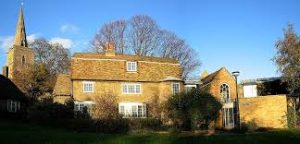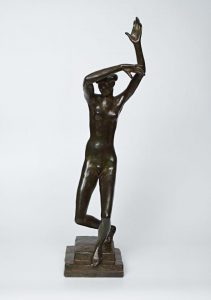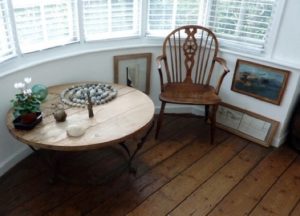People I met: Jim EDE – Cambridge Art Aficionado and Collector
Beyond The Backs, strolling from Trinity and St John’s towards Magdalene, a picture-postcard view of Cambridge can be seen in Northampton Street. The cottages are set back behind a spot of triangular green, with the steeple of St Peter’s church in the background. This view is more like a corner of rural village, rather than a place in Town. Kettle’s Yard is a cluster of small cottages of mellow brick under a heave roof of yellow-orange tiles. These buildings are linked together to form a single living space, yet nothing out of the ordinary would be thought to exist behind this elevation. The external, picturesque but modest aspect is the hallmark of the owner, Jim Ede (1895-1990), a former curator of Tate Gallery, a friend of sculptors and painters and a discerning collector of modern and contemporary British art.
Jim is of a slight, almost frail frame. He could be in his mid sixties, or perhaps seventies, one could not exactly
tell. He is of a mild manner, softly spoken, with a permanent gentle smile, inquisitive, almost ironic eyes, floating about, like a spirit of the place, radiating immense warmth and displaying an infectious love for the objects that surround him. His collection is the love of his life. Each object has a story of his encounter with the artist, an anecdote about the genesis of the particular painting or sculpture. Jim Ede has befriended the artists when they were not yet recognized by museums or the general public: he could see the potential, not as an investor, or art dealer, but as a great believer in the intrinsic aesthetic value of the oeuvre. Ben Nicholson (1894 – 1982) could not sell his paintings for years and he would let Jim have some for the price of the canvass and frame. Amongst the foreign artists was prominent the French sculptor Henri Gaudier-Brzeska (1891-1915), who lived for a while in London and who died very young, during the First War. Ede had promoted Gaudier’s works and helped the posthumous recognition of the artist. The Savage Messiah, was a biography of Gaudier, written by Jim Ede and subsequently used as a script for a British Film directed by Ken Russell (1927-2011).
The only sculptures by Henri Gaudier Brzeska, owned by the Musée d’Art Moderne in Paris, now at Beaubourg, were donated to the French nation by Jim Ede. He believed that the name of Gaudier should be recognised and honored in his native country. For his benefaction Jim was made an Officer of the Légion d’Honneur. It was not unusual for French artists to be first spotted by foreign collectors, before their fellow countrymen would acknowledge them. Major works by Gaudier, such as the Wrestlers, the Dog, the Sleeping Fawn, the Seated Woman, Bird swallowing a Fish, or the Dancer and many others were almost as if they were made specially for Kettle’s Yard, as they were blending so well with the spirit of the place.
However, the majority of the collection was composed of British modern and contemporary artists. Among these were Christopher Wood (1901-1930), Ben Nicholson, OM (1894-1982) and Winifred Nicholson (1893-1981), David Jones, CH, CBE (1895-1974), the Cornish fisherman and naïve painter Alfred Wallis (1855-1942), Henry Moore OM, CH, FBA (1898-1986), George Kennethson (1910-1994) and others. Jim Ede was a friend of them all. He was one of the first art collectors to recognize Alfred Wallis, the Cornish fisherman, who started painting at the age of 75.
At Kettle’s Yard there were works of art everywhere, even in the bathrooms and loos and generally in every corner. During the early 1970s an extension was built, in keeping with the spirit of the place, in proportion, in volume and intimacy. This new wing was to house more pictures and sculptures, as well as to make room for a Steinway grand piano, offered by the Gulbenkian Foundation, as during term time concerts were being given every Thursday.
In the early 1960s Kettle’s Yard was just a private collection, part of the Town, but not the Gown. In spite of such division, which separated them, it was the perfect example of the place where the two sides could meet and make a contribution to each other. For us, students, even those who did not read Arts, this was a home of immense inspiration and influence, a place where one could learn and appreciate beautiful things, not just oeuvres of established artists, but simple objects for every day’s use, ceramic bowls, china plates, vases, glass, or simple forms and colours of nature, like pebble stones, shells, or drift wood washed on the beach. It was natural that the Kettles Yard should eventually become part of the University, but the process was not simple, because, although Jim tried very hard to influence the administration in accepting it as a gift, this was not as straight forward a matter, as one might have thought. Eventually, in 1966, an indifferent, if sullen, University had accepted the benefaction.
By far, one of the most daring features in Kettle’s Yard’s activity was the subsidiary collection of prints and drawings which could be borrowed, for two weeks at a time, by undergraduates, in order to hang them in their own rooms in College. Instead of having a poster, or some reproduction of dubious value, one could enjoy looking, for a little while, at the work of an artist from Kettle’s Yard collection, chosen by Jim Ede. One would go to the store room under the eve, take one of the pictures from the double decker rack and put one’s name down in a book, together with the name of the College and two weeks later bring the picture back and replace it with an other one. This lending collection had an immense impact on the artistic perception of young people and perhaps its contribution was equally important and certainly more enduring than that made by formal University lectures. How many of the students who frequented the génie of the place might have become a collector of contemporary art? I should think more than one and it certainly galvanised my interest in the modern British Art, beyond the oeuvre of Henry Moore, OM, CH, MBA (1898-1986) or Graham Sutherland, OM (1903-1980), whom I knew from my Romanian days. It was a window open to a completely new world of peace, tranquillity and timelessness, all achieved through the marriage of beautiful things, put together with the greatest sensitivity in a living space, which was a Home. By going there we learned a new way of life, a new way of love and, in the process, our spirit became richer.





No Comments so far ↓
Like gas stations in rural Texas after 10 pm, comments are closed.